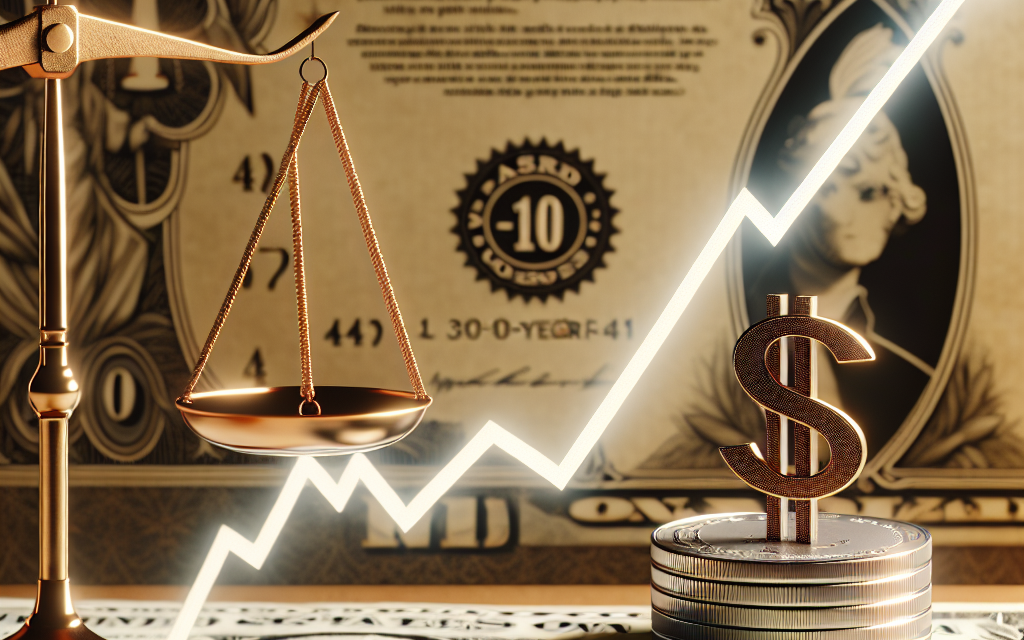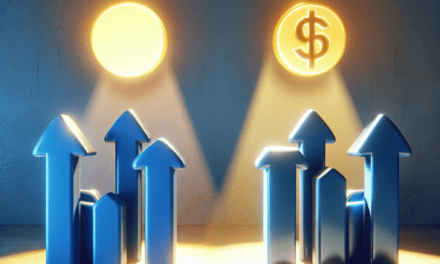“Dollar Soars to 14-Month High as 30-Year Yields Near Crucial Threshold Amid Trump’s Tariff Talks.”
Introduction
The U.S. dollar has surged to a 14-month high, driven by a combination of robust economic indicators and rising interest rates. This increase comes as 30-year Treasury yields approach a critical threshold, reflecting investor confidence in long-term economic growth. Concurrently, discussions surrounding former President Trump’s potential economic tariffs are adding a layer of complexity to the financial landscape, influencing market sentiment and currency valuations. As traders navigate these developments, the interplay between monetary policy and geopolitical considerations remains pivotal in shaping the dollar’s trajectory.
Dollar Strength: Factors Behind the 14-Month Peak
The recent surge of the U.S. dollar to a 14-month peak can be attributed to a confluence of economic factors, each playing a significant role in shaping investor sentiment and market dynamics. One of the primary drivers of this dollar strength is the ongoing adjustments in monetary policy by the Federal Reserve. As inflationary pressures persist, the Fed has signaled a commitment to maintaining higher interest rates for an extended period. This stance not only bolsters the dollar’s appeal as a safe-haven asset but also attracts foreign investment, further enhancing its value against other currencies.
In addition to the Fed’s monetary policy, the performance of U.S. economic indicators has also contributed to the dollar’s ascent. Recent data reflecting robust job growth, resilient consumer spending, and a steady manufacturing sector have instilled confidence among investors. As the U.S. economy demonstrates resilience in the face of global uncertainties, the dollar benefits from its status as the world’s primary reserve currency. Consequently, this economic strength has led to increased demand for the dollar, pushing its value higher.
Moreover, the geopolitical landscape plays a crucial role in influencing currency valuations. With ongoing tensions in various regions, including Europe and Asia, investors often seek refuge in the dollar during times of uncertainty. The dollar’s perceived stability amid global turmoil enhances its attractiveness, leading to increased buying pressure. As a result, the dollar’s strength is not merely a reflection of domestic economic conditions but also a response to international events that drive investors toward safer assets.
Furthermore, the recent rise in 30-year Treasury yields has added another layer of complexity to the dollar’s performance. As yields approach key levels, they signal potential shifts in investor expectations regarding future interest rates and economic growth. Higher yields typically indicate a stronger economy, which can lead to increased foreign investment in U.S. assets. This influx of capital further supports the dollar’s value, creating a feedback loop that reinforces its strength in the global market.
In light of these factors, it is essential to consider the implications of former President Donald Trump’s potential economic tariff considerations. Should he pursue policies that favor protectionism, the resulting trade dynamics could have far-reaching effects on the dollar’s trajectory. Tariffs can lead to increased costs for consumers and businesses, potentially stifling economic growth. If investors perceive such policies as detrimental to the U.S. economy, it could undermine the dollar’s recent gains and lead to increased volatility in currency markets.
As the dollar continues to navigate these complex economic landscapes, market participants remain vigilant, closely monitoring developments that could influence its strength. The interplay between domestic economic indicators, Federal Reserve policy, geopolitical tensions, and potential tariff implications creates a multifaceted environment for the dollar. Investors must remain agile, adapting their strategies to the evolving landscape while considering both short-term fluctuations and long-term trends.
In conclusion, the dollar’s rise to a 14-month peak is a testament to the intricate web of factors that influence currency markets. From the Federal Reserve’s monetary policy to the performance of the U.S. economy and the impact of global events, each element plays a pivotal role in shaping the dollar’s value. As the situation unfolds, the interplay of these dynamics will continue to define the dollar’s strength and its position in the global financial system.
Impact of 30-Year Yields on the Economy
The recent surge in the dollar, reaching a 14-month peak, can be closely linked to the behavior of 30-year Treasury yields, which are approaching a critical threshold. This development is significant, as long-term interest rates play a pivotal role in shaping economic conditions. When 30-year yields rise, they often signal investor confidence in the economy’s future, reflecting expectations of growth and inflation. Consequently, higher yields can lead to increased borrowing costs for consumers and businesses alike, which may dampen spending and investment.
As the 30-year yields inch closer to key levels, market participants are closely monitoring their implications for various sectors. For instance, mortgage rates, which are influenced by long-term Treasury yields, tend to rise in tandem. This increase can have a direct impact on the housing market, as higher mortgage rates may deter potential homebuyers, leading to a slowdown in home sales and construction activities. Furthermore, a cooling housing market can have ripple effects throughout the economy, affecting related industries such as home improvement, furniture, and appliances.
Moreover, the relationship between 30-year yields and the broader financial markets cannot be overlooked. When yields rise, fixed-income investments become more attractive compared to equities, prompting investors to reallocate their portfolios. This shift can lead to volatility in stock markets, as capital flows out of equities and into bonds. Consequently, companies may face increased pressure to deliver strong earnings, as higher borrowing costs can squeeze profit margins and hinder expansion plans.
In addition to these immediate effects, the rising yields also reflect broader economic sentiments. Investors often interpret increasing long-term rates as a sign that the Federal Reserve may be tightening monetary policy to combat inflation. This perception can lead to heightened uncertainty in the markets, as businesses and consumers adjust their expectations regarding future economic conditions. If the Fed is perceived to be on a path toward raising interest rates, it may prompt businesses to reconsider their investment strategies, potentially leading to a slowdown in capital expenditures.
Furthermore, the interplay between 30-year yields and the dollar is noteworthy. As yields rise, the dollar tends to strengthen, as higher interest rates attract foreign capital seeking better returns. This dynamic can create a feedback loop, where a stronger dollar further pressures U.S. exports by making them more expensive for foreign buyers. Consequently, American manufacturers may face challenges in maintaining competitiveness in the global market, which could ultimately impact job growth and economic expansion.
In light of these factors, the current economic landscape is characterized by a delicate balance. The potential for rising 30-year yields to influence consumer behavior, corporate investment, and international trade underscores the interconnectedness of financial markets and the economy. As investors remain vigilant regarding the implications of these developments, the ongoing discussions surrounding economic policies, including those related to tariffs and trade, will undoubtedly play a crucial role in shaping the trajectory of both the dollar and long-term yields. Ultimately, the interplay between these elements will determine the broader economic outlook, as stakeholders navigate the complexities of a rapidly evolving financial environment.
Trump’s Economic Tariff Considerations: Implications for the Dollar
As the dollar reaches a 14-month peak, the financial landscape is increasingly influenced by various economic factors, notably the considerations surrounding tariffs proposed by former President Donald Trump. These tariff discussions are not merely political rhetoric; they have significant implications for the dollar’s strength and the broader economic environment. The interplay between tariffs and currency valuation is complex, yet understanding this relationship is crucial for investors and policymakers alike.
To begin with, tariffs are essentially taxes imposed on imported goods, which can lead to a variety of economic outcomes. When tariffs are introduced, they can increase the cost of imported products, thereby encouraging consumers to purchase domestically produced goods. This shift can bolster domestic industries, potentially leading to job creation and economic growth. However, the immediate effect of tariffs often results in increased prices for consumers, which can stoke inflationary pressures. As inflation rises, the Federal Reserve may respond by adjusting interest rates, a move that can further influence the dollar’s value.
In the current context, the dollar’s ascent is closely tied to rising yields on long-term government bonds, particularly the 30-year Treasury yield, which is approaching a critical level. Higher yields typically attract foreign investment, as investors seek better returns on their capital. Consequently, as the dollar strengthens, it becomes more expensive for foreign buyers to purchase U.S. goods and services, potentially leading to a trade imbalance. This dynamic is particularly relevant in light of Trump’s tariff considerations, which aim to protect American industries but may inadvertently exacerbate trade tensions.
Moreover, the prospect of renewed tariffs can create uncertainty in the markets. Investors often react to uncertainty by seeking safe-haven assets, and the dollar is frequently viewed as a safe-haven currency. As a result, any indication that tariffs may be implemented can lead to increased demand for the dollar, further driving up its value. This phenomenon illustrates the dual nature of tariffs: while they are intended to protect domestic industries, they can also lead to a stronger dollar, which may undermine the competitiveness of U.S. exports.
Transitioning from the implications of tariffs on the dollar, it is essential to consider the broader economic context. The global economy is interconnected, and actions taken by the U.S. can have ripple effects worldwide. For instance, if the dollar continues to strengthen due to tariff-related uncertainties, it may lead to a slowdown in global trade. Countries that rely heavily on exports may find it increasingly difficult to compete in a market where U.S. goods are more expensive. This scenario could prompt retaliatory measures from other nations, further complicating the economic landscape.
In conclusion, Trump’s economic tariff considerations are poised to have significant implications for the dollar and the overall economy. As the dollar reaches a 14-month peak and 30-year yields approach a key level, the interplay between tariffs, inflation, and interest rates becomes increasingly critical. Investors must remain vigilant, as the evolving situation could lead to shifts in market dynamics that affect not only the dollar’s value but also the broader economic environment. Understanding these relationships will be essential for navigating the complexities of the current financial landscape, as the implications of tariff policies continue to unfold.
Analyzing the Relationship Between Currency Strength and Interest Rates
The relationship between currency strength and interest rates is a fundamental aspect of economic analysis, particularly in the context of recent developments in the financial markets. As the U.S. dollar reaches a 14-month peak, driven in part by rising 30-year Treasury yields, it becomes essential to explore how these elements interact and influence one another. Interest rates, set by central banks and influenced by various economic indicators, play a crucial role in determining the attractiveness of a currency to investors. When interest rates rise, they typically signal a stronger economy, which can lead to increased foreign investment. Consequently, this influx of capital can bolster the value of the currency.
In the current economic climate, the anticipation of higher interest rates has been fueled by various factors, including inflationary pressures and the Federal Reserve’s monetary policy stance. As the Fed contemplates its next moves, market participants closely monitor the yield on long-term government bonds, particularly the 30-year Treasury yield. When these yields approach key levels, they often reflect investor expectations regarding future interest rate hikes. A rising yield indicates that investors demand higher returns for holding long-term debt, which can be interpreted as a sign of confidence in the economy’s growth prospects. This confidence, in turn, tends to strengthen the dollar as investors seek to capitalize on higher yields.
Moreover, the interplay between currency strength and interest rates is further complicated by geopolitical considerations. For instance, recent discussions surrounding potential economic tariffs under former President Donald Trump’s administration have added an additional layer of uncertainty to the market. Tariffs can impact trade balances and inflation, which may influence the Federal Reserve’s decisions on interest rates. If tariffs lead to increased costs for consumers and businesses, the Fed may be compelled to adjust its monetary policy to mitigate inflationary pressures. Such adjustments could, in turn, affect the dollar’s value, creating a feedback loop between currency strength and interest rates.
As the dollar strengthens, it can have mixed effects on the broader economy. On one hand, a stronger dollar can make imports cheaper, benefiting consumers and businesses that rely on foreign goods. On the other hand, it can also make U.S. exports more expensive for foreign buyers, potentially leading to a trade imbalance. This dynamic is particularly relevant in the context of ongoing discussions about tariffs and trade policies, as any shifts in these areas could further influence currency valuations and interest rates.
In conclusion, the relationship between currency strength and interest rates is a complex and multifaceted one, shaped by a variety of economic and geopolitical factors. As the dollar reaches a 14-month peak and 30-year yields approach critical levels, it is essential for investors and policymakers alike to remain vigilant. Understanding how these elements interact can provide valuable insights into future market movements and economic conditions. Ultimately, the ongoing dialogue surrounding interest rates, tariffs, and their implications for the dollar will continue to be a focal point for analysts and market participants as they navigate the evolving landscape of the global economy.
Market Reactions to Economic Policies: A Focus on the Dollar
In recent weeks, the U.S. dollar has surged to a 14-month peak, reflecting a complex interplay of economic indicators and policy considerations. This rise can be attributed to various factors, including the behavior of long-term interest rates, particularly the 30-year Treasury yields, which are approaching a critical threshold. As these yields climb, they signal investor confidence in the U.S. economy, thereby bolstering the dollar’s strength in the global market. The relationship between interest rates and currency value is well-established; higher yields typically attract foreign investment, leading to increased demand for the dollar.
Moreover, the current economic landscape is further complicated by former President Donald Trump’s considerations regarding economic tariffs. His potential reintroduction of tariffs could have significant implications for trade dynamics and inflationary pressures. Investors are closely monitoring these developments, as tariffs can disrupt supply chains and alter the cost structures for businesses. Consequently, the anticipation of such policies can lead to fluctuations in currency values, as market participants adjust their expectations based on perceived risks and opportunities.
As the dollar strengthens, it is essential to consider the broader implications for the global economy. A robust dollar can create challenges for U.S. exporters, as their goods become more expensive for foreign buyers. This situation can lead to a trade imbalance, which may prompt policymakers to reassess their strategies. In contrast, a strong dollar can benefit consumers by making imported goods cheaper, thereby exerting downward pressure on inflation. However, the delicate balance between these competing forces requires careful navigation by both policymakers and market participants.
In addition to tariff considerations, the Federal Reserve’s monetary policy plays a crucial role in shaping market reactions. The central bank’s decisions regarding interest rates and quantitative easing directly influence the dollar’s value. As the Fed signals its intentions to combat inflation through potential rate hikes, the market responds by adjusting expectations for future economic growth. This dynamic creates a feedback loop, where changes in monetary policy can lead to shifts in investor sentiment, further impacting the dollar’s trajectory.
Furthermore, geopolitical factors cannot be overlooked in this context. The dollar often serves as a safe haven during times of uncertainty, and recent global events have heightened concerns about economic stability. As investors seek refuge in the dollar, its value tends to appreciate, reinforcing the currency’s status as the world’s primary reserve currency. This phenomenon underscores the interconnectedness of global markets and the influence of external factors on domestic currency valuations.
In conclusion, the recent rise of the dollar to a 14-month peak is a multifaceted development influenced by a combination of rising long-term yields, potential tariff policies, and the Federal Reserve’s monetary stance. As market participants navigate these complexities, the interplay between domestic economic policies and global market dynamics will continue to shape the dollar’s performance. Investors must remain vigilant, as shifts in sentiment and policy can lead to rapid changes in currency valuations. Ultimately, understanding these relationships is crucial for making informed decisions in an increasingly interconnected economic landscape.
Long-Term Trends: What the 30-Year Yields Signal for Investors
As the dollar reaches a 14-month peak, driven by various economic factors, the movement of 30-year yields becomes increasingly significant for investors. The recent rise in these yields signals a potential shift in the long-term economic landscape, which warrants careful consideration. Investors often look to long-term yields as a barometer for economic health and future interest rate movements. When 30-year yields approach key levels, it can indicate changing expectations regarding inflation, growth, and monetary policy.
In the current environment, the interplay between the dollar’s strength and the behavior of long-term yields is particularly noteworthy. A strong dollar typically reflects confidence in the U.S. economy, which can lead to higher yields as investors demand greater returns for holding longer-term debt. This relationship is crucial, as rising yields can influence borrowing costs for consumers and businesses alike. Consequently, when 30-year yields rise, it may signal that investors anticipate stronger economic growth, which could lead to increased spending and investment.
Moreover, the context of former President Donald Trump’s economic tariff considerations adds another layer of complexity to this scenario. Tariffs can impact inflation and economic growth, which in turn affect long-term yields. If investors believe that tariffs will lead to higher prices and reduced economic activity, they may adjust their expectations for future interest rates, causing yields to fluctuate. Therefore, understanding the implications of these tariffs is essential for investors who are trying to navigate the evolving economic landscape.
As yields approach key levels, it is also important to consider the potential for market volatility. Investors often react to changes in yields, which can lead to fluctuations in stock prices and other asset classes. For instance, if 30-year yields rise sharply, it may prompt a reassessment of equity valuations, particularly in sectors that are sensitive to interest rates, such as real estate and utilities. This dynamic underscores the interconnectedness of various financial markets and the need for investors to remain vigilant.
In addition to these factors, the broader economic indicators, such as employment data and consumer spending, play a critical role in shaping investor sentiment. Strong employment figures and robust consumer spending can bolster confidence in the economy, leading to higher yields. Conversely, weak data may prompt concerns about economic stagnation, resulting in lower yields. Thus, investors must remain attuned to these indicators as they assess the implications of rising long-term yields.
Furthermore, the global economic environment cannot be overlooked. As other central banks around the world adjust their monetary policies, the relative attractiveness of U.S. assets may shift. If foreign investors seek higher returns in the U.S. due to rising yields, this could further strengthen the dollar and influence long-term yield movements. Conversely, if global economic conditions deteriorate, capital may flow back into safer assets, impacting yields and the dollar’s strength.
In conclusion, the current landscape, characterized by a strong dollar and rising 30-year yields, presents both opportunities and challenges for investors. As they navigate these long-term trends, it is essential to consider the implications of economic policies, market volatility, and global dynamics. By staying informed and adaptable, investors can better position themselves to respond to the evolving economic environment and make informed decisions that align with their long-term financial goals.
Global Economic Outlook: The Dollar’s Role Amid Tariff Discussions
In recent weeks, the U.S. dollar has reached a 14-month peak, reflecting a complex interplay of economic factors, including rising interest rates and ongoing discussions surrounding tariffs. As the global economy continues to navigate the uncertainties brought about by geopolitical tensions and domestic policy decisions, the dollar’s strength has become a focal point for investors and analysts alike. This surge in the dollar’s value is closely tied to the movement of 30-year Treasury yields, which are approaching a critical threshold that could influence market dynamics significantly.
The dollar’s ascent can be attributed to a combination of robust economic indicators and the Federal Reserve’s monetary policy stance. As the Fed signals its commitment to combating inflation through potential interest rate hikes, the appeal of dollar-denominated assets has increased. Investors are drawn to the prospect of higher returns, which in turn bolsters demand for the dollar. Consequently, as the 30-year yields inch closer to key resistance levels, market participants are closely monitoring these developments, as they could herald shifts in investment strategies and risk appetites.
Moreover, the ongoing discussions regarding tariffs, particularly those associated with former President Donald Trump’s economic policies, add another layer of complexity to the global economic outlook. The potential reintroduction of tariffs on various imports could have far-reaching implications for trade balances and inflation rates. As businesses and consumers brace for the possibility of increased costs, the dollar’s strength may serve as a double-edged sword. On one hand, a strong dollar can help mitigate the impact of rising import prices; on the other hand, it may hinder the competitiveness of U.S. exports in the global market.
As these tariff considerations unfold, the dollar’s role as a safe-haven currency becomes increasingly significant. In times of uncertainty, investors often flock to the dollar, viewing it as a stable store of value. This behavior is particularly pronounced in the context of potential trade disruptions that could arise from tariff implementations. Consequently, the dollar’s strength may not only reflect domestic economic conditions but also the broader sentiment regarding global trade dynamics.
Furthermore, the interplay between the dollar and emerging market currencies is worth noting. A stronger dollar can create challenges for countries with significant dollar-denominated debt, as the cost of servicing such debt rises in local currency terms. This situation can lead to increased volatility in emerging markets, prompting investors to reassess their exposure to these economies. As a result, the dollar’s performance can have ripple effects across the global financial landscape, influencing capital flows and investment decisions.
In conclusion, the dollar’s recent surge to a 14-month peak is emblematic of the intricate relationship between domestic economic policies, interest rates, and global trade considerations. As 30-year yields approach critical levels, market participants remain vigilant, aware that shifts in these dynamics could have profound implications for the dollar’s trajectory. The ongoing discussions surrounding tariffs further complicate this landscape, underscoring the dollar’s dual role as both a safe haven and a potential source of economic tension. As the global economy continues to evolve, the dollar will undoubtedly remain a key player in shaping the financial outlook for both domestic and international markets.
Q&A
1. **What recent economic event has caused the dollar to reach a 14-month peak?**
– The dollar has reached a 14-month peak due to rising 30-year Treasury yields and considerations of economic tariffs by former President Trump.
2. **What are 30-year Treasury yields, and why are they significant?**
– 30-year Treasury yields are the interest rates on long-term government bonds, and they are significant as they influence borrowing costs and reflect investor confidence in the economy.
3. **How do economic tariffs impact the value of the dollar?**
– Economic tariffs can lead to increased costs for imports, potentially strengthening the dollar as investors seek safe-haven assets amid economic uncertainty.
4. **What role does investor sentiment play in the dollar’s value?**
– Investor sentiment can drive demand for the dollar; positive sentiment about the U.S. economy can lead to increased investment in dollar-denominated assets, boosting its value.
5. **What are the potential implications of a strong dollar for the U.S. economy?**
– A strong dollar can make U.S. exports more expensive for foreign buyers, potentially hurting export-driven industries, while making imports cheaper for consumers.
6. **How might Trump’s tariff considerations affect future economic policies?**
– Trump’s tariff considerations could lead to increased trade tensions, influencing future economic policies and potentially impacting inflation and growth rates.
7. **What should investors watch for regarding the dollar and Treasury yields?**
– Investors should monitor changes in Treasury yields, economic data releases, and any announcements related to trade policies or tariffs that could affect market sentiment and the dollar’s strength.
Conclusion
The recent surge of the dollar to a 14-month peak, coinciding with 30-year yields nearing a critical threshold, reflects heightened investor sentiment regarding economic stability and potential policy shifts. Trump’s considerations of economic tariffs may further influence market dynamics, impacting inflation expectations and long-term interest rates. This scenario underscores the interconnectedness of currency strength, bond yields, and trade policy, suggesting that ongoing developments in these areas will be pivotal for future economic outlooks.





